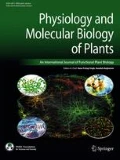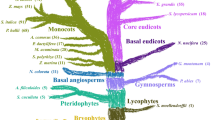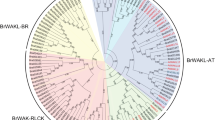Abstract
Wall Associated kinases (WAKs) represent a unique class of receptor-like kinase genes that span the plasma membrane and allow cells to recognize and respond to their extracellular environment 26 WAK/WAK-like genes were identified from the Arabidopsis genome. Functional studies of the different WAK members in Arabidopsis demonstrated that they are involved in various functions in plants, including pathogen resistance, heavy-metal tolerance and plant development. 125 genes from rice (subsp. Japonica) belonging to wall associated kinase gene family were identified by reiterative database searches. We isolated a new member of WAKs in rice, designated as OsiWAK1, the silencing of which led to impaired root development and sterility due to anther indehiscence. In the current review, we discuss about the isolation and identification of WAK members from various plant species, different domains found in the WAK proteins that make them unique and the various roles played by WAKs in the plant growth and development.
Similar content being viewed by others
References
Anderson, C.M., Wagner, T.A., Perret, M., He, Z.H., He, D. and Kohorn, B.D. (2001). WAKs: cell wall-associated kinases linking the cytoplasm to the extracellular matrix. Plant Mol. Biol. 47: 197–206.
Appella, E., Robinson, E.A., Ullrich, S.J., Stopelli, M.P., Corti, A., Cassani, G. and Blasi, F. (1987). The receptor-binding sequence of urokinase: a biological function for the growth-factor module of ptoteases. J. Biol. Chem. 262: 4437–4440.
Arabidopsis Genome Initiative (2000) Nature. 408: 796–815.
Baluska, F., Samaj, J., Wojtaszek, P., Volkmann, D. and Menzel, D. (2003). Cytoskeleton-plasma membrane-cell wall continuum in plants. Emerging links revisited. Plant Physiol. 133: 482–491.
Blanc, G., Barakat, A., Guyot, R., Cooke, R. and Delseny, M. (2000). Extensive duplication and reshuffling in the Arabidopsis genome. Plant Cell. 12: 1093–1101.
Braam, J. (1999). If walls could talk. Curr. Opin. Plant Biol. 2: 521–524.
Cao, H., Glazebrook, J., Clarke, J.D., Vilko, S. and Dong, X. (1997). The Arabidopsis NPR1 gene that controls systemic acquired resistance encodes a novel protein containing ankyrin repeats. Cell. 88: 57–63.
Cao, X., Rogers, S.W., Butler, J., Beevers, L. and Rogers, J.C. (2000). Structural requirements for ligand binding by a probable plant vacuolar sorting receptor. Plant Cell. 12: 493–506.
Carpita, N.C. and Gibeaut, D.M. (1993). Structural models of primary cell walls in flowering plants: Consistency of molecular structure with the physical properties of the walls during growth. Plant J. 3: 1–30.
Carpita, N.C., McCann, M. and Griffing, L.R. (1996). The plant extra-cellular matrix: News from the cell’s frontier. Plant Cell 8: 1451–1463.
Clark, S.E., Williams, R.W. and Meyerowitz, E.M. (1997). The CLAVATA1 gene encodes a putative receptor kinase that controls shot and floral meristem size in Arabidopsis. Cell 89: 575–585.
Clouse, S.D. (2002). Brassinosteroid signal transduction: clarifying the pathway from ligand perception to gene expression. Mol. Cell 10: 973–982.
Cosgrove, D.J. (1997). Relaxation in a high-stress environment: The molecular bases of extensible cell walls and cell enlargement. Plant Cell 9: 1031–1041.
Cosgrove, D.J. (2001). Plant cell walls: wall-associated kinases and cell expansion. Curr. Biol. 11: R558–R559.
Decreux, A. and Messiaen J. (2005). Wall-associated kinase WAK1 interacts with cell wall pectins in a calcium-induced conformation. Plant Cell Physiol. 46: 268–278.
Decreux, A., Thomas, A., Spies, B., Brasseur, R., Van Cutsem, P. and Messiaen J. (2006). In vitro characterization of the homogalacturonan-binding domain of the wall-associated kinase WAK1 using site-directed mutagenesis. Phytochemistry 67: 1068–1079.
Deeks, M.J., Hussey, P.J., and Davies, B. (2002). Formins: intermediates in signal-transduction cascades that affect cytoskeletal reorganization. Trends Plant Sci. 7: 492–498.
Fleming, A.J., McQueen-Mason, S., Mandel, T. and Kuhlemeier, C. (1997). Induction of leaf primordia by the cell wall protein expansin. Science 276: 1415–1418.
Gens, J.S., Fujiki, M. and Pickard, B.G. (2000). Arabinogalactan protein and wall-associated kinase in a plasmalemmal reticulum with specialized vertices. Protoplasma 212: 115–134.
Gomez-Gomez, L. and Boller, T. (2002). Flagellin perception: a paradigm for innate immunity. Trends Plant Sci. 7: 251–256.
Griffiths, S., Dunford, R.P., Coupland, G. and Laurie, D.A. (2003). The evolution of CONSTANS-like gene families in barley, rice and Arabidopsis. Plant Physiol., 131: 1855–1867.
Hay, E.D. (1981). Collagen and embryonic development. In ED Hay, ed, Cell Biology of the Extracellular Matrix. Plenum Press, New York, pp 379–409.
He, Z.H., Fujiki, M. and Kohorn, B.D. (1996). A cell wall-associated receptor-like protein kinase. J. Biol. Chem. 271: 19789–19793.
He, Z.H., He, D. and Kohorn, B.D. (1998). Requirement for the induced expression of a cell wall associated receptor kinase for survival during the pathogen response. Plant J. 14: 55–63.
He, Z.H., Cheeseman, I., He, D. and Kohorn, B.D. (1999). A cluster of five cell wall-associated receptor kinase genes, WAK1–5, are expressed in specific organs of Arabidopsis. Plant Mol. Biol. 39: 1189–1196.
He, Z.H., Wang, Z.Y., Li, J., Zhu, Q., Lamb, C., Ronald, P. and Chory, J. (2000). Perception of brassinosteroids by the extracellular domain of the receptor kinase BRI1. Science 288: 2360–2363.
Hou, X., Tong, H., Selby, J., Dewitt, J., Peng, X. and He, Z.H. (2005). Involvement of a cell wall-associated kinase, WAKL4, in Arabidopsis mineral responses. Plant Physiol. 139: 1704–1716
Hynes, R.O. (1981). Fibronectin and its relation to cellular structure and behavior. In ED Hay, ed, Cell Biology of the Extracellular Matrix. Plenum Press, New York, pp 295–334.
Hynes, R.O. (1987). Integrins: A family of cell surface receptors. Cell 48: 549–554.
Kemp, B.P. and Doughty, J. (2003). Just how complex is the Brassica S-receptor complex? J. Exp. Bot. 54: 157–168.
Koch, K. (2004). Sucrose metabolism: regulatory mechanisms and pivotal roles in sugar sensing and plant development. Curr. Opin. Plant Biol. 7: 235–246.
Kohorn, B.D. (2000). Plasma membrane-cell wall contacts. Plant Physiol. 124: 31–38.
Kohorn, B.D. (2001). WAKs; cell wall associated kinases. Curr. Opin. Cell Biol. 13: 529–533.
Kohorn, B.D., Kobayashi, M., Johansen, S., Riese, J., Huan, L.F., Koch, K., Fu, S., Dotson, A. and Byers, N. (2006a). An arabidopsis cell wall-associated kinase required for invertase activity and cell growth. Plant J. 46: 307–316.
Kohorn, B.D., Kobayashi, M., Johansen, S., Friedman, H.P., Fischer, A. and Byers, N. (2006b). Wall-associated kinase 1 (WAK1) is crosslinked in endomembranes, and transport to the cell surface requires correct cell-wall synthesis. J. Cell Sci. 119: 2282–2290.
Kuroda, S. and Tanizawa, K. (1999). Involvement of epidermal growth factor-like domain of NELL proteins in the novel protein-protein interaction with protein kinase C. Biochem. Biophys. Res. Commum. 265: 752–757.
Lally, D., Ingmire, P., Tong, H.Y. and He, Z.H. (2001). Antisense expression of a cell wall-associated protein kinase, WAK4, inhibits cell elongation and alters morphology. Plant Cell 13: 1317–1333.
Lijavetzky, D., Carbonero, P. and Vicente-Carbajosa, J. (2003). Genome-wide comparative phylogenetic analysis of rice and Arabidopsis Dof gene families. BMC Evol. Biol. 3: 17.
MacDougall, A.J., Brett, G.M., Morris, V.J., Rigby, N.M., Ridout, M.J. and Ring, S.G. (2001). The effect of peptide-pectin interactions on the gelation behaviour of a plant cell wall pectin. Carbohydr. Res. 335: 115–126.
Mathieu, Y., Guern, J., Spiro, M.D., O’Neill, M.A., Kates, K., Darvill, A.G. and Albersheim, P. (1998). The transient nature of the oligogalaturonide-induced ion fluxes of tobacco cells is not correlated with fragmentation of the oligoga-lacturonides. Plant J. 16: 305–311.
McCarty, D.R. and Chory, J. (2000). Conservation and innovation in plant signaling pathways. Cell 103: 201–209.
Nakhamchik, A., Zhao, Z., Provart, N.J., Shiu, S.H., Keatley, S.K., Cameron, R.K. and Goring, D.R. (2004). A comprehensive expression analysis of the Arabidopsis proline-rich extensin-like receptor kinase gene family using bioinformatic and experimental approaches. Plant Cell Physiol. 45: 1875–1881.
Nicol, F., His, I., Jauneau, A., Vernhettes, S., Canut, H. and Hofte, H. (1998). A plasma membrane-bound putative endo-1,4-â-D-glucanase is required for normal wall assembly and cell elon-gation in Arabidopsis. EMBO J. 17: 5563–5576.
Oxley, D. and Bacic, A. (1999). Structure of the glycosylphosphatidylinositol anchor of an arabinogalactan protein from Pyrus communis suspension-cultured cells. Proc. Natl. Acad. Sci. USA 25: 14246–14251.
Park, A.R., Cho, S.K., Yun, U.J., Jin, M.Y., Lee, S.H., Sachetto-Martins, G. and Park, O.K. (2001). Interaction of the Arabidopsis receptor protein kinase Wak1 with a glycine-rich protein, AtGRP-3. J. Biol. Chem. 276: 26688–26693.
Pear, J.R., Kawagoe, Y., Schreckengost, W.E., Delmer, D.P. and Stalker, D.M. (1996). Higher plants contain homologs of the bacterial celA genes encoding the catalytic subunit of cellulose synthase. Proc. Natl. Acad. Sci. USA, 93: 12637–12642.
Pont-Lezica, R.F., McNally, J.G. and Pickard, B.G. (1993). Wall-to-membrane linkers in onion epidermis: Some hypotheses. Plant Cell Environ. 16: 111–123.
Reymond, P., Grunberger, S., Paul, K., Muller, M. and Farmer, E.E. (1995). Oligogalacturonide defense signals in plants: large fragments interact with the plasma membrane in vitro. Proc. Natl. Acad. Sci. USA 92: 4145–4149.
Roberts, K. (1994). The plant extracellular matrix: In a new expansive mood. Curr. Opin. Cell Biol. 6: 688–694.
Rojo, E., Sharma, V.K., Kovaleva, V., Raikhel, N.V. and Fletcher, J.C. (2002). CLV3 is localized to the extracellular space, where it activates the Arabidopsis CLAVATA stem cell signaling pathway. Plant Cell 14: 969–977.
Schafer, S. and Schmulling, T. (2002). The CRK1 receptor-like kinase gene of tobacco is negatively regulated by cytokinin. Plant Mol. Biol. 50: 155–166.
Scheer, J.M. and Ryan, C.A. Jr (2002). The systemin receptor SR160 from Lyco-persicon peruvianum is a member of the LRR receptor kinase family. Proc. Natl. Acad. Sci. USA 99: 9585–9590.
Schenk, P.M., Kazan, K., Wilson, I., Anderson, J.P., Richmond, T., Somerville, S.C. and Manners, J.M. (2000). Coordinated plant defense responses in Arabidopsis revealed by microarray analysis. Proc. Natl. Acad. Sci. USA, 97: 11655–11660.
Schindelman, G., Morikami, A., Jung, J., Baskin, T.I., Carpita, N.C., Derbyshire, P., McCann, M.C. and Benfey, P.N. (2001). COBRA encodes a putative GPI-anchored protein, which is polarly localized and necessary for oriented cell expansion in Arabidopsis. Genes Dev. 15: 1115–1127.
Schopfer, C.R., Nasrallah, M.E. and Nasrallah, J.B. (1999). The Male Determinant of Self-Incompatibility in Brassica. Science 286: 1697–1700.
Shiu, S.H. and Bleecker, A.B. (2001). Receptor-like kinases from Arabidopsis form a monophyletic gene family related to animal receptor kinases. Proc. Natl. Acad. Sci. USA 98: 10763–10768.
Sivaguru, M., Ezaki, B., He, Z.H., Tong, H., Osawa, H., Baluska, F., Volkmann, D. and Matsumoto, H. (2003). Aluminum-induced gene expression and pro-tein localization of a cell wall-associated receptor kinase in Arabidopsis. Plant Physiol. 132: 2256–2266.
Stenberg, Y., Muranyi, A., Steen, C., Thulin, E., Drakenberg, T. and Stenflo, J. (1999). EGF-like module pair 3–4 in vitamin K-dependent protein S: modulation of calcium affinity of module 4 by module 3, and interaction with factor X. J. Mol. Biol. 293: 653–665.
Stenflo, J., Stenberg, Y. and Muranyi, A. (2000). Calcium-binding EGF-like modules in coagulation proteinases: function of the calcium ion in module interactions. Biochim Biophys Acta. 1477: 51–63.
Stracke, S., Kistner, C., Yoshida, S., Mulder, L., Sato, S., Kaneko, T., Tabata, S., Sandal, N., Stougaard, J., Szczyglowski, K. and Parniske, M. (2002). A plant receptor-like kinase required for both bacterial and fungal symbiosis. Nature 417: 959–962.
Sunnerhagen, M.S., Ullner, M., Persson, E, Teleman, O., Stenflo, J. and Drakenberg, T. (1992). How an epidermal growth factor (EGF)-like domain binds calcium: high resolution NMR structure of the calcium form of the NH2-terminal EGF-like domain in coagulation factor X. J. Biol. Chem. 267: 19642–19649.
Sunnerhagen, M.S., Persson, E., Dahlqvist, I., Drakenberg, T., Stenflo, J., Mayhew, M., Robin, M., Handford, P., Tilley, J.W. and Campbell, I.D. (1993). The effect of aspartate hydroxylation on calcium binding to epidermal growth factor-like modules in coagulation factors IX and X. J. Biol. Chem. 268: 23339–23344.
Svetek, J., Yadav, M.P. and Nothnagel, E.A. (1999). Presence of a glycosylphosphatidylinositol lipid anchor on rose arabinogalactan proteins. J. Biol. Chem. 274: 14724–14733.
Takayama, S., Shiba, H., Iwano, M., Shimosato, H., Che, F.S., Kai, N., Watanabe, M., Suzuki, G., Hinata, K. and Isogai, A. (2000). The pollen determinant of self-incompatibility in Brassica campestris 97: 1920–1925.
Torii, K.U. (2004). Leucine-rich repeat receptor kinases in plants: structure, function, and signal transduction pathways. Int. Rev. Cytol. 234: 1–46.
Trotochaud, A.E., Hao, T., Wu, G., Yang, Z. and Clark, S.E. (1999). The CLAVATA1 receptor-like kinase requires CLAVATA3 for its assembly into a signaling complex that includes KAPP and a Rho-related protein. Plant Cell 11: 393–406.
Verica, J.A. and He, Z.H. (2002). The cell wall-associated kinase (WAK) and WAK-like kinase gene family. Plant Physiol. 129: 455–459.
Verica, J.A., Chae, L., Tong, H., Ingmire, P. and He, Z.H. (2003). Tissue-specific and developmentally regulated expression of a cluster of tandemly arrayed cell wall-associated kinase-like kinase genes in Arabidopsis. Plant Physiol. 133: 1732–1746.
Vydehi (2007). Functional Characterization of novel genes encoding for Wall Associated Kinase (WAK), Stress Associated protein (SAP) and Pectin methyl esterase (PME) from rice (var indica). Thesis submitted to Madurai Kamaraj University, Madurai, India.
Wagner, T.A. and Kohorn, B.D. (2001). Wall-associated kinases are expressed throughout plant development and are required for cell expansion. Plant Cell 13: 303–318.
Wyatt, S.E. and Carpita, N.C. (1993). The plant cytoskeleton-cell-wall continuum. Trends Cell Biol. 3: 413–417.
Wymer, C. and Lloyd, C. (1996). Dynamic microtubules: Implica-tions for cell wall patterns. Trends Plant Sci. 1: 222–228.
Yang, E.J, Oh, Y.A., Lee, E.S., Park, A.R., Cho, S.K., Yoo, Y.J. and Park, O.K. (2003). Oxygen-evolving enhancer protein 2 is phosphorylated by glycine-rich protein 3/wall-associated kinase 1 in Arabidopsis. Biochem. Biophys. Res. Commun. 305: 862–868.
Zhang, S., Chen, C., Li, L., Meng, L., Singh, J., Jiang, N., Deng, X.W., He, Z.H. and Lemaux, P.G. (2005). Evolutionary expansion, gene structure, and expression of the rice wall-associated kinase gene family. Plant Physiol. 139: 1107–1124.
Zhu, J.K., Shi, J., Singh, U., Wyatt, S.E., Bressan, R.A., Hasegawa, P.M. and Carpita, N.C. (1993). Enrichment of vitronectin-and fibronectin-like proteins in NaCl-adapted plant cells and evidence for their involvement in plasma membrane-cell wall adhesion. Plant J. 3: 637–648.
Zushi, M., Gomi, K., Yamamoto, S., Maruyama, I., Hayashi, T. and Suzuki, K. (1989). The last three consecutive epidermal growth factor-like structures of human thrombomodulin comprise the minimum functional domain for protein C-activating cofactor activity and anticoagulant activity. J. Biol. Chem. 264: 10351–10353.
Author information
Authors and Affiliations
Corresponding author
Rights and permissions
About this article
Cite this article
Kanneganti, V., Gupta, A.K. Wall associated kinases from plants — an overview. Physiol Mol Biol Plants 14, 109–118 (2008). https://doi.org/10.1007/s12298-008-0010-6
Published:
Issue Date:
DOI: https://doi.org/10.1007/s12298-008-0010-6




